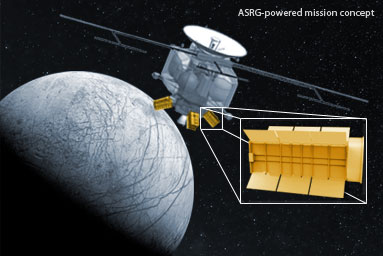
|
Exploring Space Power Systems |
||||||||
|
|||||||||
 |

Mathematics Skill or Topic Area:
Multi-Step Equations
Next Gen Science Framework ESS3.A Natural resources; PS1B Chemical reactions; PS3.A Definitions of matter; PS3.B Conservation of energy and energy transfer; PS3.C Relationship between energy and forces; ETS1.A: Defining and Delimiting an Engineering Problem ; ETS1.B: Developing Possible Solutions ; ETS1.C: Optimizing the Design Solution
Common Core ELA for Science: RST.6-8.2. Determine the central ideas or conclusions of a text; provide an accurate summary of the text distinct from prior knowledge or opinions.RST.6-8.8. Distinguish among facts, reasoned judgment based on research findings, and speculation in a text. RST.6-8.9. Compare and contrast the information gained from experiments, simulations, video, or multimedia sources with that gained from reading a text on the same topic.
Common Core Math Standard: CCS.8.SP.A.1 Construct and interpret scatter plots for bivariate measurement data to investigate patterns of association between two quantities; CCS.8.SP.A.2 Know that straight lines are widely used to model relationships between two quantitative variables; CCS.8.SP.A.3 Use the equation of a linear model to solve problems in the context of bivariate measurement data, interpreting the slope and intercept.

Video Engagement: What are Radioisotope Power Systems? NASA uses Radioisotope Power Systems, or RPS, to convert heat from radioactive decay to electricity, creating predictable, continuous power for long missions in extreme environments. Learn how a next generation Radioisotope Stirling Engine will perform four times more efficiently and help NASA use even less of a precious resource. (7 minutes) View Program
|
Engage your students with a press release: From a Source of Heat Comes Power to Explore
Radioisotope power systems, or RPS, provide electricity and heat that can enable spacecraft to undertake scientific missions to environments beyond the capabilities of solar power, chemical batteries and fuel cells.
RPS are sometimes referred to as a type of "nuclear battery." While some spacecraft, like Cassini, do run their systems directly off of their RPS, others like the Mars Science Laboratory rover can use the RPS to charge batteries and run their systems and instruments off of stored battery power. In either case, the RPS is attached directly to a spacecraft, much like a power cord being plugged in.
These technologies are capable of producing electricity and heat for decades under the harsh conditions of deep space without refueling. All of these power systems, flown on more than two dozen NASA missions since the 1960s, have functioned for longer than they were originally designed.
The RPS used to power NASA spacecraft are supplied by the U.S. Department of Energy (DOE). NASA and DOE continue to collaborate on maintaining and developing several types of RPS.
Press release date line - April 27, 2012 Press release
location: [
Click Here ] |
|
Explore math connections with SpaceMath@NASA
Problem I - Solar Electricity - Students calculate the sizes of solar power arrays and their generated power and learn about the watts per square meter efficiency factor. [ Open PDF ]
Problem II -
Radioisotope Thermoelectric Systems -
Students perform basic math related to RTGs including temperature conversion and mass verses power calculations.
[ Open
PDF ]
Explain
your thinking: Write
your own problem - Using information
found in the Math Connection problems, the press release or the video
program, create your own math problem. Explain why you set the problem up this
way, and how you might find its answer.
Evaluate
your understanding: Challenge Problem -
Designing a Power System for Juno. Solar and RTG systems produce electricity, but each requires a specific
amount of mass to do so. In this problem,
students compare the mass versus output electricity for both systems to estimate their masses for the Juno mission.
[ Open
PDF ]

NASA / JPL
3-D Solar System
Extend your new knowledge - Visit EOSS to study the Rosetta and Mars Global Surveyor solar power systems, and learn about the Inverse-Square Law for designing a mission to Saturn. [ Open PDF ]